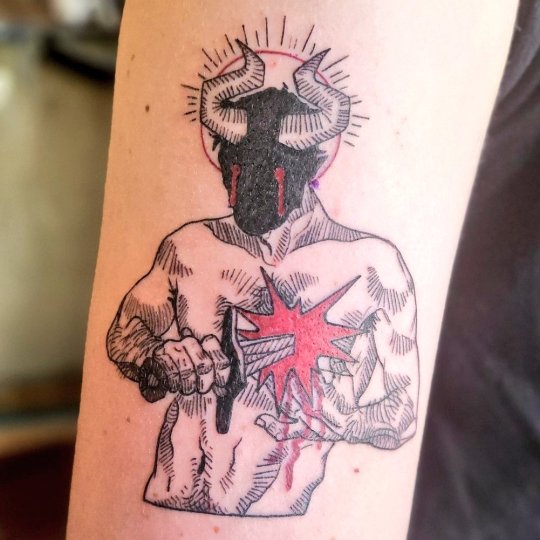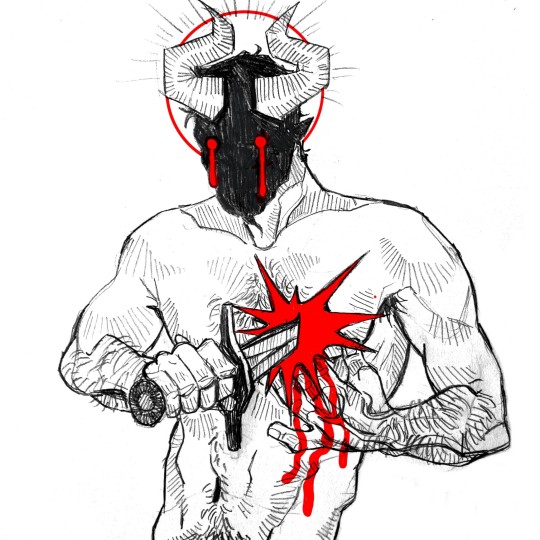#Always happy to do tatt commissions
Explore tagged Tumblr posts
Text


So cool to do this tattoo commission for @supersoldiervigilante about a month ago! Here's the finished tatt!
#The tattooist did such a good job!#Always happy to do tatt commissions#art#sketch#character art#Demon#Tattoo#Blood
202 notes
·
View notes
Note
Do you have any advice for a newbie looking to get their first tattoo?
The first step is to think a lot about what you want to get and where on your body you want it. Look at a lot of pictures of tattoos. The place to do this is Instagram. I do not like Instagram and honestly, this is the only thing I use this for. At first, just look at all sorts of tatts and try to get a feel for what appeals to you and what doesn't. Save pictures of your faves. You don't need to look for things that are exactly what you want--you might like the linework in one and the coloring in another, but you're going to want to be able to put together a coherent "story" of what you want for your artist to work from.
Once you have a good idea of what you want, you will need to find an artist in your area (or an area you're willing to travel to). At least where I live, there are various studios and then artists work out of those studios who usually handle their bookings independently. (Note: I live in an American major metropolitan area, but not in the city itself) You may want to google studios near you, and they will have a website that lists their artists and offers some samples of their work. If you see someone you like, they may have their own Insta or website that shows more of their work. The artist will almost always have instructions somewhere in here for how to book them. The tattoo studio websites may also have instructions, but in my experience, it's better to contact the artist directly if you can. I am also lucky in that I have a lot of tattooed pals and we share recommendations. If you have inked friends, ask them about their experiences!!
A lot of artists will offer ready-to-go designs that are available, meaning, you can just sign up and they'll tattoo exactly that on your body. If you see something that's perfect, this will speed up the process a bit.
Otherwise, you contact them and tell them what you're thinking. DO read all their guidelines before you contact them-- most of the artists I've seen are very specific about what info they want you to provide. Once you've sent that in, if your idea sounds like something they want to do, they'll schedule a consult. My consult for my first tattoo was in person, and my guy had sketches for me to look at and we chatted about it. I was pretty happy with what he'd done and we scheduled a session after that. For my second tatt, we did the consult over email and she emailed me a draft. Some artists don't want to do this, it's up to them! My upcoming consult is over the phone for covid reasons.
Up to the consult stage, it's perfectly fine to not go with that artist. This is the part where "this is permanent" comes in. You might want to suggest big changes and they might try again or you might say "I'm gonna go with someone else". In both my cases, mine only needed minor tweaks and I trusted my artists, so we went forward. At that point, you put down a deposit (mine were ~$100) and schedule a session. Tattoos may take more than one session, but mine took one each.
Respectable tattoo studios take sanitation very seriously and that includes covid. Read through their guidelines and make sure you're on the same page with them. A friend of mine got a tatt a few months ago and said she felt like it was one of the most well-protected activities she did during the pandemic, but obviously there are going to be some studios that take this more serious than others. If you don't feel good about a studio find another one. There are many good and safe studios out there. Also, covid messed up a lot of peoples' schedules-- many artists may be backlogged and they may not be taking new clients right now, although it seems to me like things are starting to open up a lot more right now.
A few other tips:
- Read up on rates and be prepared for the cost including tip (15-20%). I have two relatively simple, B&W tatts and they were a couple hundred bucks. Elaborate tatts can easily run into the thousands. But remember, you're commissioning an artist, you should treat them with the respect they deserve!
- People always talk about the pain thing. Personally, getting tattooed is not painful to me, I actually kinda enjoy the sensation. People experience pain differently, though, ymmv. There are also parts of the body that are more or less painful if this is a concern for you.
- Read up on the aftercare process, just so you know what's involved. Generally, you've got about two weeks of washing it carefully and moisturizing, but you shouldn't go to the beach or get in a hot tub, etc, so you might want to plan around vacations.
I hope that helps and good luck!
#tattoos#this is not the only way to get a tattoo but it's my experience#and i'm very happy with the way it went both times so far
18 notes
·
View notes
Text
Fig Taylor
Earlier this year I met with Portfolio Consultant Fig Taylor and had the opportunity to show her my Portfolio.
She was originally a Graphic Designer and then an Illustrator with a constant online presence. She explained that clients will expect when they open your portfolio to get an insight as to who you are and suggests you select styles, not lots of everything. If you are a Jack Of All Trades then be ruthless for yourself and select who is true to you most. Fig talked about getting into industry and what clients are looking for, she said they client will be ruthless when picking an illustrator for their work.
Fig said to have work in your portfolio that you like, be positive and enthusiastic about it. Be about 87% happy with your work in your portfolio, so think through what you show clients and be confident! Not critical of yourself. She said there is always a period of regeneration after a degree to get work, as criteria is different for employers and clients, rather than experimental art for tutors. Clients want just to see almost perfection with no down days. Know the objectivity of your work – learn to be your own ‘constructive’ critique. If need be clear out and refresh your portfolio and put in what you like best. Remember that weak work sticks out in the mind; lousy work brings the overall portfolio down! Important to have it represent you!
She is a mentor for Cockpit Art – she said if it is you put it in the prime position / prominent [first] or at the top. Take out work you cannot deliver e.g. techniques you can��t replicate e.g. etching, screen printing etc. or things that are time consuming too – style to the time constraint of the client.
Advice for the technical side of Portfolio use the DO’s & DONT’s of Portfolio’s A3/A4 Industry Standard, Light and Portable, Easy and Accessible! Choose A3 to display still good not much re-sizing required and accessible for double page spread. No life drawings and no general sketchbook ‘tatt’ that is sentimental. Some clients may / may not be interested in sketchbooks – you can have scans. Children’s Books like to see sketchbooks to see character development. Have examples of finished illustrations. For example Food and Drink agencies – the Artist didn’t draw tomatoes so didn’t get commissioned for Tomato Seed Packet. Be expansive and show what you can draw for what they want, they aren’t mind readers and will be ruthless. Don’t forget to PROTECT ARTWORK!
Fig explained there is not a magic number of pieces in a Portfolio so use common sense, show off work in appropriate manner that suits your style and layout, mounting the pieces wisely, frame work, avoid colour paper unless it enhances the artwork. Don’t shy away from double page spreads in your Portfolio, photograph things professionally – precise and clean. Clean, concise, to the point that represents you!
She discussed Digital Portfolio’s saying you can have more images but still a small concise selection, if you have back ups to support digital then be ORGANISED. She explained that ipads are good for digital as simpler but obviously a laptop is still fine but easier to go wrong and liability – BE VERY PREPARED! So don’t borrow laptops if you don’t know how they work! Important be sensible when considering such things as slideshows or Animations on YouTube. The key is being clean, concise and planned out, so easy like a normal print portfolio would be. NO MUSIC ON WEBSITES!
Websites / Web Presence and Blogs
Her advice was that for the Illustrator their website is a CV and a Blog is a covering letter. Your blog keeps them in your orbit and shows what you would be like to work with. Instagram /Blog/Facebook – Professional Standard! Promoting yourself online so write how you want to be portrayed, write about your processes and successes not rubbish – keeps tabs on your career and is relaxed more than a website so important to write a if your chatting to a friend about your work and goings on, obviously keeping it relevant and making points worth saying.
Illustrators A to B
Fig Taylor said ‘Magazines are probably your first starting point’ gain Commercial Commissions, bearing in mind that magazines pay the least amount of money. Their interest is a fast process and turnover. Book Advertising is a lot harder to get a job but the bigger the job is the more important and expensive [lots of people involved!] Contact magazines – look at all magazines available! Consumer and customer trade/professional, wide variety of people. Magazine of particular purchase e.g. Waitrose own magazine or subscription is better, because produced by limited commission. Trade and Professional magazine work give you greater creative freedom, more edgy experimental, less competition – these publications have diversity of style.
Her advice was to research extensively when you are promoting your work for the first time, when you don’t know the client. Then send a physical letter to the Art Director and include some examples of your work from digital linked to their industry – insure you have done your homework! Ring them and tell them that you will and ask if they want you. Then give it a week and email – if specified. After they know you and have corresponded.
I found this to be a valuable input, such extensive advice on entering the world of a freelance illustrator.
0 notes